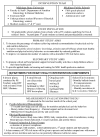(S)Partners for Heart Health: a school-based program for enhancing physical activity and nutrition to promote cardiovascular health in 5th grade students
- PMID: 19102777
- PMCID: PMC2628664
- DOI: 10.1186/1471-2458-8-420
(S)Partners for Heart Health: a school-based program for enhancing physical activity and nutrition to promote cardiovascular health in 5th grade students
Abstract
Background: The American Heart Association Position Statement on Cardiovascular Health Promotion in Public Schools encourages school-based interventions for the primary prevention of cardiovascular disease (CVD) through risk factor prevention or reduction in children with an emphasis on creating an environment that promotes healthy food choices and physical activity (PA). In an effort to address issues related to CVD risk factors including obesity in Michigan children, a multi-disciplinary team of Michigan State University (MSU) faculty, clinicians, and health profession students was formed to "(S)partner" with elementary school physical education (PE) teachers and MSU Extension staff to develop and implement a cost-effective, sustainable program aimed at CVD risk factor prevention and management for 5th grade students. This (S)partnership is intended to augment and improve the existing 5th grade PE, health and nutrition curriculum by achieving the following aims: 1) improve the students' knowledge, attitudes and confidence about nutrition, PA and heart health; 2) increase the number of students achieving national recommendations for PA and nutrition; and 3) increase the number of students with a desirable CVD risk factor status based on national pediatric guidelines. Secondary aims include promoting school staff and parental support for heart health to help children achieve their goals and to provide experiential learning and service for MSU health profession students for academic credit.
Methods/design: This pilot effectiveness study was approved by the MSU IRB. At the beginning and the end of the school year students undergo a CVD risk factor assessment conducted by MSU medical students and graduate students. Key intervention components include eight lesson plans (conducted bi-monthly) designed to promote heart healthy nutrition and PA behaviors conducted by PE teachers with assistance from MSU undergraduate dietetic and kinesiology students (Spartners). The final 10 minutes of each lesson, MSU Spartners conduct small breakout/discussion groups with the 5th grade students. Additionally, each Spartner case manages/mentors two to three 5th grade students using a web-based goal setting and tracking protocol throughout the school year.
Discussion: This paper describes the rationale, development, and methods of the Spartners for Heart Health program. This is a multi-level intervention designed to promote heart healthy behaviors and prevent or manage CVD risk factors in children. We believe this will be a viable sustainable intervention that can be disseminated and adopted by other institutions with minimal cost by engaging college students as an integral part of the measurement and intervention teams.
Figures
Similar articles
-
A cluster randomized trial to evaluate the efficacy of a school-based behavioral intervention for health promotion among children aged 3 to 5.BMC Public Health. 2013 Jul 15;13:656. doi: 10.1186/1471-2458-13-656. BMC Public Health. 2013. PMID: 23855415 Free PMC article. Clinical Trial.
-
A school-based intervention program in promoting leisure-time physical activity: trial protocol.BMC Public Health. 2018 Apr 2;18(1):433. doi: 10.1186/s12889-018-5320-1. BMC Public Health. 2018. PMID: 29609570 Free PMC article. Clinical Trial.
-
It's all about kids: preventing overweight in elementary school children in Tulsa, OK.J Am Diet Assoc. 2009 Apr;109(4):680-7. doi: 10.1016/j.jada.2008.12.021. J Am Diet Assoc. 2009. PMID: 19328263 Clinical Trial.
-
Supporting public health priorities: recommendations for physical education and physical activity promotion in schools.Prog Cardiovasc Dis. 2015 Jan-Feb;57(4):368-74. doi: 10.1016/j.pcad.2014.09.010. Epub 2014 Sep 28. Prog Cardiovasc Dis. 2015. PMID: 25269062 Review.
-
Obesity prevention and the Health promoting Schools framework: essential components and barriers to success.Int J Behav Nutr Phys Act. 2015 Feb 13;12:15. doi: 10.1186/s12966-015-0167-7. Int J Behav Nutr Phys Act. 2015. PMID: 25885800 Free PMC article. Review.
Cited by
-
Knowledge of school teachers and the associating factors in the effective delivery of the school health programme in Nigeria.Pan Afr Med J. 2022 Sep 2;43:4. doi: 10.11604/pamj.2022.43.4.30838. eCollection 2022. Pan Afr Med J. 2022. PMID: 36284886 Free PMC article.
-
Exploring the Cost of eLearning in Health Professions Education: Scoping Review.JMIR Med Educ. 2021 Mar 11;7(1):e13681. doi: 10.2196/13681. JMIR Med Educ. 2021. PMID: 33704073 Free PMC article.
-
FitKids360: design, conduct, and outcomes of a stage 2 pediatric obesity program.J Obes. 2014;2014:370403. doi: 10.1155/2014/370403. Epub 2014 Aug 20. J Obes. 2014. PMID: 25215228 Free PMC article.
-
Determining independence and associations among various cardiovascular disease risk factors in 9-12 years old school-children: a cross sectional study.BMC Public Health. 2022 Aug 30;22(1):1639. doi: 10.1186/s12889-022-14035-6. BMC Public Health. 2022. PMID: 36042444 Free PMC article.
-
Evaluation of a health promotion program in children: Study protocol and design of the cluster-randomized Baden-Württemberg primary school study [DRKS-ID: DRKS00000494].BMC Public Health. 2012 Mar 6;12:157. doi: 10.1186/1471-2458-12-157. BMC Public Health. 2012. PMID: 22394693 Free PMC article. Clinical Trial.
References
-
- Hayman LL, Williams CL, Daniels SR, Steinberger J, Paridon S, Dennison BA, McCrindle BW. Cardiovascular health promotion in the schools: a statement for health and education professionals and child health advocates from the Committee on Atherosclerosis, Hypertension, and Obesity in Youth (AHOY) of the Council on Cardiovascular Disease in the Young, American Heart Association. Circulation. 2004;110:2266–2275. doi: 10.1161/01.CIR.0000141117.85384.64. - DOI - PubMed
-
- Enos WF, Beyer JC, Holmes RH. Pathogenesis of coronary disease in American soldiers killed in Korea. J Am Med Assoc. 1955;158:912–914. - PubMed
-
- Mahoney LT, Burns TL, Stanford W, Thompson BH, Witt JD, Rost CA, Lauer RM. Coronary risk factors measured in childhood and young adult life are associated with coronary artery calcification in young adults: the Muscatine Study. J Am Coll Cardiol. 1996;27:277–284. doi: 10.1016/0735-1097(95)00461-0. - DOI - PubMed
Publication types
MeSH terms
LinkOut - more resources
Full Text Sources
Medical


